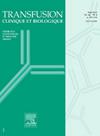Assessment of machine learning classifiers for predicting intraoperative blood transfusion in non-cardiac surgery
IF 1.2
4区 医学
Q4 HEMATOLOGY
引用次数: 0
Abstract
Background
This study aimed to develop a machine learning classifier for predicting intraoperative blood transfusion in non-cardiac surgeries.
Methods
Preoperative data from 6255 patients were extracted from the VitalDB database, an open-source registry. The primary outcome was the area under the receiver operating characteristic (AUROC) curve of ML classifiers in predicting intraoperative blood transfusion, defined as the receipt of at least one unit of packed red blood cells. Five different machine learning algorithms including logistic regression, random forest, adaptive boosting, gradient boosting, and the extremely gradient boosting classifiers were used to construct a binary classifier for intraoperative blood transfusion, and their predictive abilities were compared.
Results
337 (5%) patients received intraoperative blood transfusion. In the test-set, the logistic regression classifier demonstrated the highest AUROC (0.836, 95% CI, 0.795–0.876), followed by the gradient boosting classifier (0.810, 95% CI, 0.750–0.868), AdaBoost classifier (0.776, 95% CI, 0.722–0.829), random forest classifier (0.735, 95% CI, 0.698–0.771), and XGBoost classifier (0.721, 95% CI, 0.695–0.747). The logistic regression classifier showed a higher AUROC compared to that of a multivariable logistic regression model (0.836 vs. 0.623, P < 0.001). Among various parameters used to construct the logistic regression classifier, the top three most important features were operation time (0.999), preoperative serum hemoglobin level (0.785), and open surgery (0.530).
Conclusion
We successfully developed various ML classifiers using readily available preoperative data to predict intraoperative transfusion in patients undergoing non-cardiac surgeries. In particular, the logistic regression classifier demonstrated the best performance in predicting intraoperative transfusion.
评估预测非心脏手术术中输血的机器学习分类器。
背景:本研究旨在开发一种用于预测非心脏手术术中输血的机器学习分类器:本研究旨在开发一种用于预测非心脏手术术中输血的机器学习分类器:从开源注册数据库 VitalDB 数据库中提取了 6255 名患者的术前数据。主要结果是机器学习分类器预测术中输血的接收者操作特征曲线下面积(AUROC),术中输血定义为接受至少一个单位的包装红细胞。我们使用了五种不同的机器学习算法,包括逻辑回归、随机森林、自适应提升、梯度提升和极梯度提升分类器,构建了术中输血的二元分类器,并比较了它们的预测能力:结果:337 例(5%)患者接受了术中输血。在测试集中,逻辑回归分类器的 AUROC 最高(0.836,95% CI,0.795-0.876),其次是梯度提升分类器(0.810,95% CI,0.750-0.868)、AdaBoost 分类器(0.776,95% CI,0.722-0.829)、随机森林分类器(0.735,95% CI,0.698-0.771)和 XGBoost 分类器(0.721,95% CI,0.695-0.747)。与多变量逻辑回归模型相比,逻辑回归分类器的AUROC更高(0.836 vs. 0.623,P < 0.001)。在用于构建逻辑回归分类器的各种参数中,最重要的前三个特征是手术时间(0.999)、术前血清血红蛋白水平(0.785)和开放手术(0.530):我们利用现成的术前数据成功开发了多种 ML 分类器,用于预测非心脏手术患者的术中输血情况。尤其是逻辑回归分类器在预测术中输血方面表现最佳。
本文章由计算机程序翻译,如有差异,请以英文原文为准。
求助全文
约1分钟内获得全文
求助全文
来源期刊
CiteScore
2.50
自引率
11.80%
发文量
234
审稿时长
36 days
期刊介绍:
Transfusion Clinique et Biologique, the official journal of the French Society of Blood Transfusion (SFTS):
- an aid to training, at a European level
- the only French journal indexed in the hematology and immunology sections of Current Contents
Transfusion Clinique et Biologique spans fundamental research and everyday practice, with articles coming from both sides. Articles, reviews, case reports, letters to the editor and editorials are published in 4 editions a year, in French or in English, covering all scientific and medical aspects of transfusion: immunology, hematology, infectious diseases, genetics, molecular biology, etc. And finally, a convivial cross-disciplinary section on training and information offers practical updates.
Readership:
"Transfusers" are many and various: anesthetists, biologists, hematologists, and blood-bank, ICU and mobile emergency specialists...

 求助内容:
求助内容: 应助结果提醒方式:
应助结果提醒方式:


